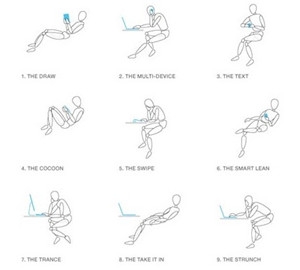
We forget exactly when we became the slaves of computers. Until a few years ago we got information from the Internet by using stationary computers. They sat on a table while everything around them, humans included, moved with relative flexibility.
不知从何时起,我们沦为电脑的奴隶。就在几年前,我们还在用台式机来从互联网上获取信息。它们被放置在桌上,而包括人在内的周遭一切则都围着它转。
But as smartphones and tablets — computers developed for their mobility — become more common in our lives, they’re changing not just the way we communicate with other people, but the way our bodies relate to our surroundings.
但如今智能手机与便携式平板电脑在日常生活中日益普及,它们不仅改变了人与人之间的沟通方式,也改变了我们的身体与周围环境互动的方式。
Steelcase, a US office furniture manufacturer, has caught on to this trend, which is proving especially popular at work. The company realized that its product designs would need to adapt to new mobile-enabled workplaces. So it conducted a study of office workers — 2,000 of them across 11 countries — to see how they relate to the many devices they now rely on to get their work done.
美国办公家具制造商Steelcase公司因为紧随这一趋势,而格外受到职场人士的欢迎。这家公司意识到自己的产品设计需要满足办公环境的移动性需求。于是他们邀请了来自全球11个国家的2000名上班族参与一项研究,想借此探寻他们是如何利用众多办公设备来完成工作的。
Through observations, interviews and snapshots of people at work, Steelcase concluded that the way we compute is changing the way we sit. The company identified nine new postures we had never seen before, all of which are “driven by this new breed of devices”.
通过对他们工作情形的观察、访谈和拍照,Steelcase公司总结出这样的结论:我们使用电脑的方式正在改变着我们的坐姿。同时该公司也盘点出九种我们从未见过的全新姿势,它们都随着全新电子产品的面世应运而生。
The draw
向后倚靠
The often-seen “lean back” experience of tablet reading, done in a chair. This posture requires good back support from a chair, especially for the head and neck.
人们常常会坐在椅子上“向后依靠”着使用平板电脑。这种姿势需要椅子给予背部尤其是头颈部良好的支撑。
The multi-device
多元设备
You’re using your laptop and your phone at the same time. This requires good arm rests, provided by either tabletop or chair.
你需要同时使用笔记本电脑和手机时,需要桌面或椅子提供一个舒适的扶手。
The text
短信输入
You’re sitting at your desk, using your handheld device to read, e-mail and, yes, text. Arm rests aren’t required, but they’re ideal.
你坐在桌边,使用掌上设备来阅读、收发邮件,当然,还有发短信。尽管这时不需要扶手支撑,但如果有的话更完美。
The cocoon
蚕茧姿势
This is a scrunched-up body posture usually reserved for reading, though it can be used for typing as well. The sitters lean back, pull up their legs, bend their knees, and draw their devices close to their bodies. This is, Steelcase notes, a posture used more often by women than men.
这种把身体蜷缩起来的阅读姿势通常在读书时采用,当然打字时也用这个姿势。坐着时向后倚靠,蜷起双腿,弯曲膝盖,把电子设备放到眼前。Steelcase公司注意到,女士比男士更常用这种姿势。
The swipe
坐立触控
The sitter leans over his or her desk, directly over a touchscreen device. This posture is pretty much exclusive to tablet or smartphone use.
坐着时俯身桌上,位于触屏设备的正上方。这种姿势是平板电脑和智能手机用户的专用姿势。
The smart lean
灵活后倾
A compromise between the lean-back posture of “the draw” and a more standard sitting style, this posture allows the sitter to check his or her smartphone in a relaxed posture while also retaining a bit of privacy when it comes to what’s being shown on the screen. It’s especially popular during meetings, or any occasion when there are other people around.
这种姿势介于”向后倚靠姿势”和标准坐姿之间,让你在坐着时能用一种放松的姿势来查看自己的手机,而同时也能为所看内容保有隐私。这种姿势常见于会议中,或者有旁人在场的场合。
The trance
全神贯注
You’re absorbed in whatever you’re doing, leaning into your table and toward your computer, with arms placed either on the chair’s armrests or on your desk. This posture often involves slouching.
你沉浸于手头的事,身体向办公桌和电脑前倾,双臂放在椅子的扶手上或者桌子上。这种姿势通常同懒散画上等号。
The take-it-in
放平仰卧
This can also be called the “all the way back” and involves nearly fully reclining in one’s chair. It’s popular in front of large, high-resolution monitors that allow people to see the screen from a distance.
这种姿势也被称为“全身后靠”,近乎平躺在椅子上。那些坐在高分辨率的大显示器前的人往往会选用这种坐姿,因为这样从远处便可看清屏幕。
The “strunch”
弯腰伸展
This is “stretching out” and “hunching” at the same time: When people get tired they tend to push their monitor or device away from them and find a new screen angle by slouching down toward their desks. They then prop themselves up with their arms on their desk, sometimes propping their chin up with a free hand.
这是一种弓起背部的蜷缩“伸展”姿势:当人累了的时候,他们往往会将显示器或电子设备推远一点,调整屏幕的新角度,弯腰曲背靠着桌子,显得很懒散。然后,他们会把胳膊支撑在桌面上,有时会用空闲的那只手支撑着下巴。


